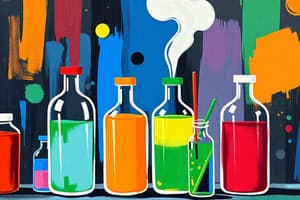Podcast
Questions and Answers
What is the top priority when working in the laboratory?
What is the top priority when working in the laboratory?
Safety
Chemical safety only focuses on human health.
Chemical safety only focuses on human health.
False (B)
Which inhalation types can lead to chemical exposure?
Which inhalation types can lead to chemical exposure?
- Gases
- Vapors
- Mists
- All of the above (correct)
What type of hazards can cause burns or corrosion?
What type of hazards can cause burns or corrosion?
Match the chemical hazards with their descriptions:
Match the chemical hazards with their descriptions:
The ______ is the primary engineering control for capturing and removing hazardous airborne contaminants.
The ______ is the primary engineering control for capturing and removing hazardous airborne contaminants.
What must be done if there is skin or eye contact with chemicals?
What must be done if there is skin or eye contact with chemicals?
Eating and drinking are allowed in the laboratory.
Eating and drinking are allowed in the laboratory.
What document provides information on chemical properties and hazards?
What document provides information on chemical properties and hazards?
What is used to classify hazardous waste produced in laboratories?
What is used to classify hazardous waste produced in laboratories?
How long should you rinse skin or eyes for most corrosives?
How long should you rinse skin or eyes for most corrosives?
Flashcards are hidden until you start studying
Study Notes
Laboratory Safety
- Safety is the top priority when working in any laboratory.
- Republic Act 11058 in the Philippines strengthens compliance with occupational safety and health standards related to chemical safety.
Chemical Exposure Risks
- Exposure to chemicals can cause serious health effects, both immediate and long-term.
- Inhalation is the most common form of chemical exposure in the workplace, including gases, vapors, mists, dusts, fumes, and smoke.
- Eating and drinking are strictly prohibited in the laboratory to prevent chemical contamination.
Chemical Hazards and Labeling
- Chemicals can cause irritation, burns, or vision loss through skin and eye contact.
- Direct entry of chemicals into the body through punctures or wounds poses a serious health risk.
- Safety Data Sheets (SDS) provide essential information on chemical properties, hazards, safe handling, storage, and emergency measures.
- Standardized pictograms on labels are used to caution users of chemical hazards.
Hazard Communication
- The NFPA hazard diamond is a color-coded system that rates a chemical's health, flammability, and reactivity hazards.
- Proper labeling is necessary when disposing of chemicals, which can be obtained from the PCS laboratory.
Hazardous Waste Management
- DENR Administrative Order No. 2013-22 classifies hazardous waste produced in laboratories and provides corresponding waste numbers.
- This classification supports the faster identification and proper segregation of waste products for disposal.
Personal Protective Equipment (PPE)
- Essential PPE includes:
- Body protection: Lab coats and potentially chemical-resistant sleeves or aprons.
- Eye and face protection: Safety glasses with side shields, goggles for splashes, and face shields.
- Hand protection: Disposable nitrile gloves for incidental exposure and heavy-duty gloves for increased protection.
- Respiratory protection: Used when engineering controls like fume hoods are insufficient.
Chemical Storage and Handling
- Label containers with the date they were first opened, especially for materials prone to form organic peroxides.
- Specific storage guidelines must be considered based on chemical hazards:
- Acids and bases should be stored separately, away from incompatible materials.
- Flammables need to be stored in a flammable-safe refrigerator or cabinet, away from ignition sources.
- Oxidizers require storage in a cool, dry place separate from flammable materials.
- Peroxide-forming chemicals should be stored in airtight, dark, and cool conditions.
- Compressed gases need to be stored securely, upright, with labels indicating their status, and valve caps replaced when not in use.
Emergency Response
- Immediate rinsing with water is advised for skin or eye contact.
- Seek medical attention if necessary and continue rinsing during transport.
- Small chemical spills can be cleaned up with absorbent material and neutralized if necessary for acid or base spills.
- For large spills, evacuate the area, close doors and windows, activate fire alarms, call 911, and report the incident to the supervisor.
Safety Equipment
- Fire extinguishers are important for putting out fires.
- Fume hoods are used to capture and remove hazardous airborne contaminants.
- Safety showers and eyewashes serve as devices that wash chemicals off of people in emergency situations.
Studying That Suits You
Use AI to generate personalized quizzes and flashcards to suit your learning preferences.



